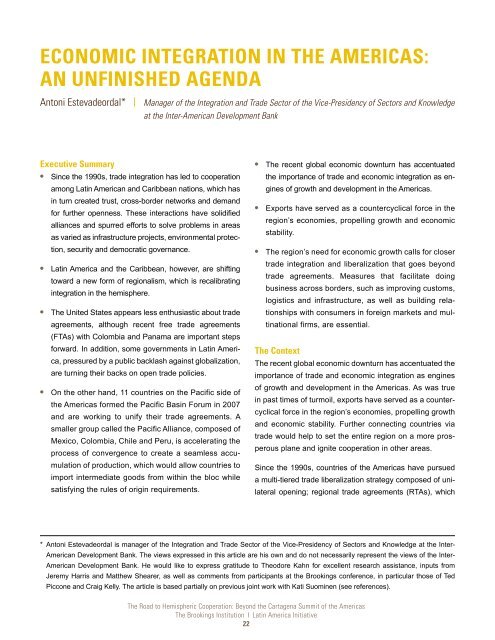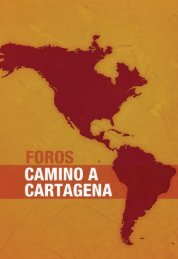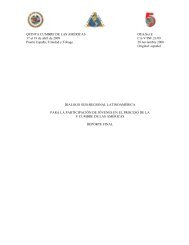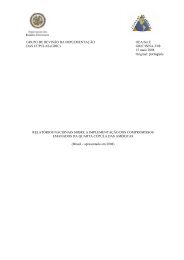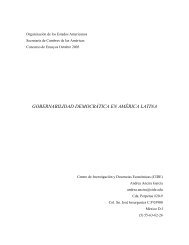The Road to Hemispheric Cooperation: Beyond the Cartagena
The Road to Hemispheric Cooperation: Beyond the Cartagena
The Road to Hemispheric Cooperation: Beyond the Cartagena
Create successful ePaper yourself
Turn your PDF publications into a flip-book with our unique Google optimized e-Paper software.
ECONOMIC INTEgRATION IN THE AMERICAS:<br />
AN uNfINISHED AgENDA<br />
An<strong>to</strong>ni Estevadeordal* I Manager of <strong>the</strong> Integration and Trade Sec<strong>to</strong>r of <strong>the</strong> Vice-Presidency of Sec<strong>to</strong>rs and Knowledge<br />
at <strong>the</strong> Inter-American Development Bank<br />
Executive Summary<br />
●● Since <strong>the</strong> 1990s, trade integration has led <strong>to</strong> cooperation<br />
among Latin American and Caribbean nations, which has<br />
in turn created trust, cross-border networks and demand<br />
for fur<strong>the</strong>r openness. <strong>The</strong>se interactions have solidified<br />
alliances and spurred efforts <strong>to</strong> solve problems in areas<br />
as varied as infrastructure projects, environmental protection,<br />
security and democratic governance.<br />
●● Latin America and <strong>the</strong> Caribbean, however, are shifting<br />
<strong>to</strong>ward a new form of regionalism, which is recalibrating<br />
integration in <strong>the</strong> hemisphere.<br />
●● <strong>The</strong> United States appears less enthusiastic about trade<br />
agreements, although recent free trade agreements<br />
(FTAs) with Colombia and Panama are important steps<br />
forward. In addition, some governments in Latin America,<br />
pressured by a public backlash against globalization,<br />
are turning <strong>the</strong>ir backs on open trade policies.<br />
●● On <strong>the</strong> o<strong>the</strong>r hand, 11 countries on <strong>the</strong> Pacific side of<br />
<strong>the</strong> Americas formed <strong>the</strong> Pacific Basin Forum in 2007<br />
and are working <strong>to</strong> unify <strong>the</strong>ir trade agreements. A<br />
smaller group called <strong>the</strong> Pacific Alliance, composed of<br />
Mexico, Colombia, Chile and Peru, is accelerating <strong>the</strong><br />
process of convergence <strong>to</strong> create a seamless accumulation<br />
of production, which would allow countries <strong>to</strong><br />
import intermediate goods from within <strong>the</strong> bloc while<br />
satisfying <strong>the</strong> rules of origin requirements.<br />
●● <strong>The</strong> recent global economic downturn has accentuated<br />
<strong>the</strong> importance of trade and economic integration as engines<br />
of growth and development in <strong>the</strong> Americas.<br />
●● Exports have served as a countercyclical force in <strong>the</strong><br />
region’s economies, propelling growth and economic<br />
stability.<br />
●● <strong>The</strong> region’s need for economic growth calls for closer<br />
trade integration and liberalization that goes beyond<br />
trade agreements. Measures that facilitate doing<br />
business across borders, such as improving cus<strong>to</strong>ms,<br />
logistics and infrastructure, as well as building relationships<br />
with consumers in foreign markets and multinational<br />
firms, are essential.<br />
<strong>The</strong> Context<br />
<strong>The</strong> recent global economic downturn has accentuated <strong>the</strong><br />
importance of trade and economic integration as engines<br />
of growth and development in <strong>the</strong> Americas. As was true<br />
in past times of turmoil, exports have served as a countercyclical<br />
force in <strong>the</strong> region’s economies, propelling growth<br />
and economic stability. Fur<strong>the</strong>r connecting countries via<br />
trade would help <strong>to</strong> set <strong>the</strong> entire region on a more prosperous<br />
plane and ignite cooperation in o<strong>the</strong>r areas.<br />
Since <strong>the</strong> 1990s, countries of <strong>the</strong> Americas have pursued<br />
a multi-tiered trade liberalization strategy composed of unilateral<br />
opening; regional trade agreements (RTAs), which<br />
* An<strong>to</strong>ni Estevadeordal is manager of <strong>the</strong> Integration and Trade Sec<strong>to</strong>r of <strong>the</strong> Vice-Presidency of Sec<strong>to</strong>rs and Knowledge at <strong>the</strong> Inter-<br />
American Development Bank. <strong>The</strong> views expressed in this article are his own and do not necessarily represent <strong>the</strong> views of <strong>the</strong> Inter-<br />
American Development Bank. He would like <strong>to</strong> express gratitude <strong>to</strong> <strong>The</strong>odore Kahn for excellent research assistance, inputs from<br />
Jeremy Harris and Mat<strong>the</strong>w Shearer, as well as comments from participants at <strong>the</strong> Brookings conference, in particular those of Ted<br />
Piccone and Craig Kelly. <strong>The</strong> article is based partially on previous joint work with Kati Suominen (see references).<br />
<strong>The</strong> <strong>Road</strong> <strong>to</strong> <strong>Hemispheric</strong> <strong>Cooperation</strong>: <strong>Beyond</strong> <strong>the</strong> <strong>Cartagena</strong> Summit of <strong>the</strong> Americas<br />
<strong>The</strong> Brookings Institution ❘ Latin America Initiative<br />
22


